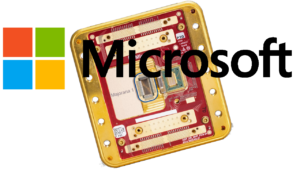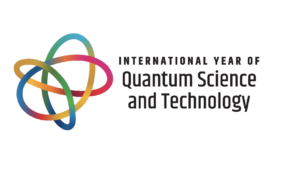“Scientists have observed something fascinating about the universe: A tiny particle can spontaneously appear from nothing and then disappear as if it had never existed,” writes Thomas Lee (@ByTomLee). “The same could be said of quantum computers, a transformative supercomputing technology with the potential to disrupt every industry imaginable. That’s why Google, Microsoft, and Amazon founder Jeff Bezos have invested millions into the idea. But like those weird particles, quantum computing seems to pop into the public consciousness every few years only to disappear back into the minds of obscure scientists.” [“Quantum computing’s reality fluctuates over time,” SFGate, 3 July 2014] In a post entitled “Quantum Future: Just Beyond Our Grasp,” I noted that, despite the many breakthroughs that have advanced progress towards quantum computing, a fully functioning quantum computer always seems just out of reach. Paul Benioff, a retired physicist with Argonne National Laboratory, told Lee, “We’ve made progress, but we’ve got a long ways to go.” This time around, the pattern pointed out by Lee may be broken. With so much money and so many well-known people involved in the pursuit of a quantum computer, I don’t think that quantum computing will once again “disappear back into the minds of obscure scientists.”
As Lee points out, Microsoft is one of the organizations interested in pursuing a quantum computer. Although other groups and individuals have been grabbing the headlines in recent years, Joe Crabtree reminds us that “in 2006, Microsoft created the Station Q research group at the University of California, Santa Barbara to study quantum computing.” [“Microsoft’s Bet On The Next Big Thing – Quantum Computing,” Perficient Microsoft, 27 June 2014] Crabtree reports, “Microsoft is pursuing a slightly different form of quantum computing known as topical quantum computing, precisely controlling the motions of pairs of subatomic particles as they wind around one another would manipulate entangled quantum bits.” In an article about Microsoft’s effort, John Markoff (@markoff) writes, “By weaving the particles around one another, topological quantum computers would generate imaginary threads whose knots and twists would create a powerful computing system.” [“Microsoft Makes Bet Quantum Computing Is Next Breakthrough,” The New York Times, 23 June 2014] Markoff continues:
“Most important, the mathematics of their motions would correct errors that have so far proved to be the most daunting challenge facing quantum computer designers. First proposed by the physicist Richard Feynman in 1982, quantum computing has mostly been of interest to academics, the National Security Agency and the Pentagon’s Defense Advanced Research Projects Agency. But in recent years, quantum computing has caught the attention of the corporate world.”
In a post entitled “Searching for a Less Quirky Qubit,” I noted that Bell Labs scientist, Bob Willett, is also attempting to create a “topological qubit.” [“Forging a Qubit to Rule Them All,” by Natalie Wolchover, Quanta Magazine, 15 May 2014] Both the Bell Labs and Microsoft efforts are based on a particle called an anyon. Markoff asserts these efforts are “high-risk … because the type of exotic anyon particle needed to generate qubits has not been definitively proved to exist.” He continues:
“That may change soon. [Microsoft] has been spending heavily and is contributing to 10 of the roughly 20 academic research groups exploring a long-hypothesized class of subatomic particles known as Majorana fermions. Beyond being a scientific advance, proving the existence of the Majorana would mean that it was likely they could be used to form qubits for this new form of quantum computing.”
Graphene may be the key to unlock the secret of anyons. In a previous post about quantum computing, I reported that researchers have discovered that graphene is a “fault tolerant” material that can help reduce the fragility of quantum computing systems. Tina Casey (@TinaMCasey) reports, “An international team of researchers based at MIT has figured out how to make the edges of the two-dimensional wonder material graphene behave like one-dimensional electronic wires. I know, right? To ice the cake, the edges don’t have to be perfectly formed. They can be irregular or ‘dirty’ and those electrons would still go zipping along in the right direction. In terms of quantum computers, that’s an important advantage for graphene. … Graphene is cheap compared to other materials with quantum computer potential but it is notoriously difficult to fabricate perfect examples in bulk, so if a measure of imperfection does not interfere with its efficiency, finding applications for it would be that much more likely.” [“Dirty Or Clean, Graphene Could Make A Nice Little Quantum Computer,” CleanTechnica, 23 December 2013] Casey calls graphene “the nanomaterial of the new millennium.” The Perimeter Institute for Theoretical Physics, calls graphene “not just a practical wonder – it’s also a wonderland for theorists.” [“From pencil marks to quantum computers,” phys.org, 3 July 2014] The article continues:
“There are two kinds of particles in our three-dimensional world: fermions (such as electrons), where two identical particles can’t occupy one state, and bosons (such as photons), where two identical particles actually want to occupy one state. In three dimensions, fermions are fermions and bosons are bosons, and never the twain shall meet. But a sheet of graphene doesn’t have three dimensions – it has two. It’s effectively a tiny two-dimensional universe, and in that universe, new phenomena can occur. For one thing, fermions and bosons can meet halfway – becoming anyons, which can be anywhere in between fermions and bosons. The quasiparticles in these special stair-step states are expected to be anyons. In particular, the [Perimeter researchers Zlatko Papić and Dmitry (Dima) Abanin] are hoping these quasiparticles will be non-Abelian anyons, as their theory indicates they should be. That would be exciting because non-Abelian anyons can be used in the making of qubits.”
Non-Abelian anyons are the type of particles with which Willett is experimenting. Wolchover reports, “Willett’s experiment is so difficult that no other labs have managed to replicate it.” The work being done by Abanin and Papić provide more evidence that Willett’s experiments are not simply an artifact of his work that can’t be duplicated elsewhere. The phys.org article concludes:
“The drive to make qubits is part of the reason why graphene is a hot research area in general, and why even-denominator FQHE states – with their special anyons– are sought after in particular. ‘A state with some number of these anyons can be used to represent a qubit,’ says Papić. ‘Our theory says they should be there and the experiments seem to bear that out – certainly the even-denominator FQHE states seem to be there, at least according to the Geneva experiments.’ That’s still a step away from experimental proof that those even-denominator stair-step states actually contain non-Abelian anyons. More work remains, but Papić is optimistic: ‘It might be easier to prove in graphene than it would be in semiconductors. Everything is happening right at the surface.’ It’s still early, but it looks as if bilayer graphene may be the magic material that allows this kind of qubit to be built.”
Other Perimeter researchers claim to have discovered a “magic ingredient” that advances progress towards a fully functional quantum computer. [“Researchers Fine ‘Magic’ Ingredient for Quantum Computing,” Perimeter Institute for Theoretical Physics, 11 June 2014] The article reports:
“A team of quantum information researchers, including Perimeter Institute Affiliate member Joseph Emerson, has shown that a phenomenon known as quantum contextuality is necessary for the ‘magic’ behind universal quantum computation. Building on previous theoretical work by Perimeter researchers in quantum information and quantum foundations, the new research brings practical quantum technologies another step closer to reality. ‘The result gives us a deeper understanding of the nature of quantum computation and clarifies the practical requirements for designing a realistic quantum computer,’ said Emerson, a faculty member at the Institute for Quantum Computing (IQC) at the University of Waterloo and a fellow of the Canadian Institute for Advanced Research (CIFAR).”
Since one of the unique things about quantum computers is the fact that you can never observe what is going on inside the computer, what does occur seems like magic. Contextuality helps explain this magic. The article continues:
“Contextuality is one of the counterintuitive features of quantum theory that distinguish the quantum world from the realm of our everyday experience. In the classical world, measurements reveal existing properties, such as colour or mass, that are subject to observation or measurement. In the quantum regime, however, a property you discover through measurement is not a property the system had prior to the measurement process. What you measure necessarily depends on how you carried out the observation – it depends on the ‘context’ of the experiment. That distinction, the researchers discovered, is the key to unlocking the potential power of quantum computation. ‘Before these results, we didn’t necessarily know what resources were needed for a physical device to achieve the advantage of quantum information,’ said lead author Mark Howard, a postdoctoral fellow at IQC. ‘Now we know one. As researchers work to build a universal quantum computer, understanding the minimum physical resources required is an important step to finding ways to harness the power of the quantum world.’ One of the major hurdles to harnessing the power of a universal quantum computer is finding practical ways to control fragile quantum states. In this context, Howard, Emerson, Joel Wallman (IQC) and Victor Veitch (University of Toronto) have achieved theoretical confirmation that contextuality is a necessary resource for achieving the advantages of quantum computation.”
Although the term “magic” may seem frivolous, it has a specific meaning in quantum computing. The article explains:
“The term ‘magic’ refers to a particular approach to building noise-resistant quantum computers known as magic-state distillation. To overcome the detrimental effects of unwanted noise, so-called ‘fault-tolerant’ techniques are developed and employed. Magic states are an essential (but difficult to achieve and maintain) extra ingredient that boosts the power of a quantum device to achieve the improved processing power of a quantum computer. By identifying these magic states as contextual, researchers will be able to clarify the trade-offs involved in different approaches. It might help design new algorithms that exploit the special properties of these magic states more fully.”
Two things should be obvious from this discussion. First, despite so many bits and pieces of the quantum computing puzzle being worked on, no one has yet been able to put them all together to create a fully functional quantum computer. Second, no single country has a dominant lead in the field of quantum computing. Lee concludes, “For the United States to claim leadership in quantum computing, the country needs a coordinated national strategy funded by both taxpayers and the private sector (that means you, Silicon Valley) – the same model we’re using to map out the human brain and genome and to cure cancer.” If quantum computing is really going to be the game changer that most analysts claim it will be, leadership in the field could bring enormous economic benefits.




